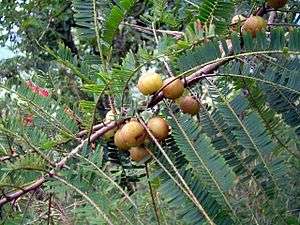Triphala
Triphala (/triːˈfɑːlə/ or /triːˈfælə/; Hindi/Sanskrit: त्रिफला, triphalā [trɪˈpʰɐlaː], “three fruits”)[1] is an Ayurvedic[2] herbal rasayana formula consisting of equal parts of three myrobalans, taken without seed: Amalaki (Emblica officinalis), Bibhitaki (Terminalia bellirica), and Haritaki (Terminalia chebula).[1]
Medicinal use
In traditional Ayurvedic medicine, Triphala is used for:
- immune system stimulation[3]
- improvement of digestion[1][4]
- relief of constipation[1][4]
- gastrointestinal tract cleansing[4]
- relief of gas (carminative)[1]
- treatment of diabetes[1]
- treatment of eye disease[1]
These health claims have not been yet tested in clinical trials on humans. Even within the practice of Ayurvedic medicine, there are controversies about the composition (amlaki, haritaki and bibhitaki), preparation, and medicinal uses of Triphala.[5]
Active constituents
The active constituents are unknown. Triphala contains several compounds that have been proposed to be responsible for its claimed health benefits, including gallic acid, chebulagic acid, and chebulinic acid.[6][7]
Contemporary research on triphala
There is preliminary evidence that Triphala contains compounds with antioxidant properties in isolated cells and rats, but this has not yet been demonstrated in people.[6][8][9][10] Triphala has significant immunostimulatory effects on cellular immune response, especially cytotoxic T cells and natural killer cells.[11] Triphala extract significantly prevents selenite-induced experimental cataractogenesis in vitro and in vivo for rats.[12]
See also
References
- 1 2 3 4 5 6 7 Ayurvedic pharmacopoeia committee. The Ayurvedic Formulary of India, Part I, 2nd English ed. New Delhi: Controller of Publications; 2003
- ↑ Anne McIntyre (7 September 2005). Herbal treatment of children: Western and Ayurvedic perspectives. Elsevier Health Sciences. pp. 278–. ISBN 9780750651745. Retrieved 24 July 2010.
- ↑ Juss SS. Triphala - the wonder drug. Indian Med Gaz 1997;131:94-6.
- 1 2 3 Nadkarni AK. Indian Materia Medica. 3rd ed. Mumbai: Popular Press; 1976. p. 1308-15.
- ↑ Harbans Singh Puri (2003). Rasayana: ayurvedic herbs for longevity and rejuvenation. CRC Press. pp. 30–. ISBN 9780415284899. Retrieved 24 July 2010.
- 1 2 Reddy TC, Aparoy P, Babu NK, Kalangi SK, Reddanna P (May 2010). "Kinetics and Docking Studies of a COX-2 Inhibitor Isolated from Terminalia bellerica Fruits". Protein Pept Lett. 17 (10): 1251–7. PMID 20441561.
- ↑ Pawar V, Lahorkar P, Anantha Narayana DB. Development of a RP-HPLC method for analysis of Triphala curna and its applicability to test variations in Triphala curna preparations. Indian J Pharm Sci [serial online] 2009 [cited 2010 Aug 1];71:382-6. Available from: http://www.ijpsonline.com/text.asp?2009/71/4/382/57286
- ↑ Mahesh R, Bhuvana S, Begum VM (August 2009). "Effect of Terminalia chebula aqueous extract on oxidative stress and antioxidant status in the liver and kidney of young and aged rats". Cell Biochem. Funct. 27 (6): 358–63. doi:10.1002/cbf.1581. PMID 19548245.
- ↑ Sandhya T, Lathika KM, Pandey BN, et al. (October 2006). "Protection against radiation oxidative damage in mice by Triphala". Mutat. Res. 609 (1): 17–25. doi:10.1016/j.mrgentox.2006.05.006. PMID 16860592.
- ↑ Srikumar R, Parthasarathy NJ, Manikandan S, Narayanan GS, Sheeladevi R (February 2006). "Effect of Triphala on oxidative stress and on cell-mediated immune response against noise stress in rats". Mol. Cell. Biochem. 283 (1-2): 67–74. doi:10.1007/s11010-006-2271-0. PMID 16444587.
- ↑ Phetkate, Pratya; Kummalue, Tanawan; U-pratya, Yaowalak; Kietinun, Somboon. "Significant Increase in Cytotoxic T Lymphocytes and Natural Killer Cells by Triphala: A Clinical Phase I Study". Evidence-Based Complementary and Alternative Medicine. 2012: 1–6. doi:10.1155/2012/239856.
- ↑ Gupta, SureshKumar; Kalaiselvan, V; Srivastava, Sushma; Agrawal, ShyamS; Saxena, Rohit. "Evaluation of anticataract potential of Triphala in selenite-induced cataract: In vitro and in vivo studies". Journal of Ayurveda and Integrative Medicine. 1 (4): 280. doi:10.4103/0975-9476.74425.
